Samos is a gorgeous island in the Eastern Aegean, just 1 km from the coast of Turkey. Samos is considered one of the most beautiful islands of the Aegean, often called the queen of the Eastern Aegean. If you choose Samos for your Greek island vacation, you are in for a treat: there is lush nature, stunning beaches, and amazing history to enjoy and experience.
Samos is perfect for any vacation style, making it an excellent destination even for a group of diverse interests. From cosmopolitan to authentically picturesque, at Samos, you will be able to find adventure, culture, luxury, and relaxation as you want it. Samos is where you want to be if you’re looking for flexibility in your vacations in an unforgettable corner of paradise.
To fully experience Samos and everything it offers, read on to find out everything you need to know.
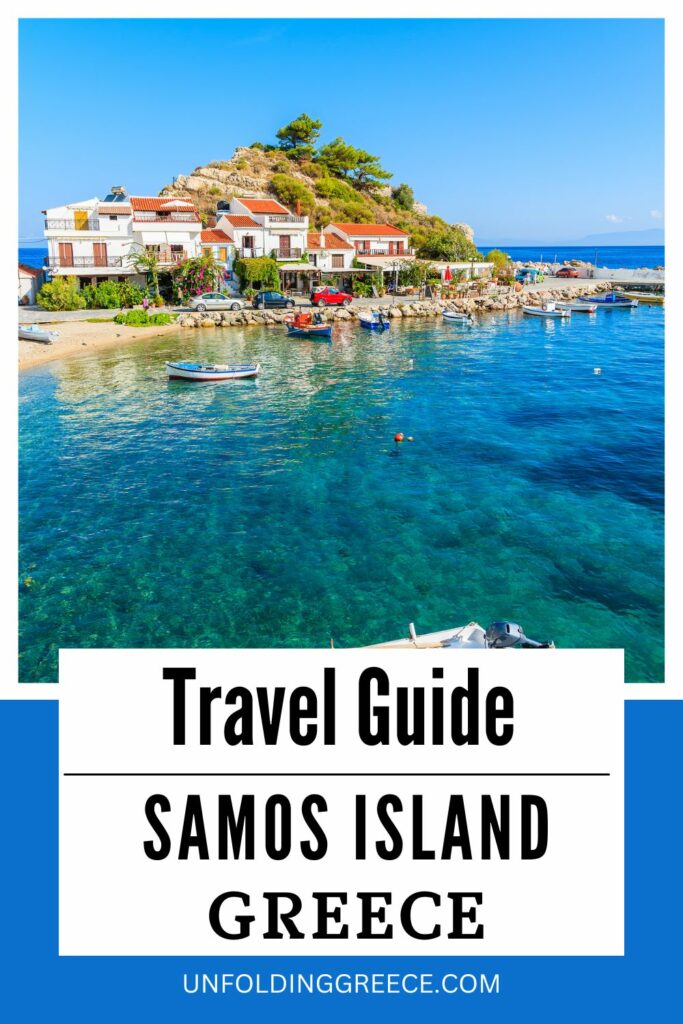
Disclaimer: This post contains affiliate links. This means that I will receive a small commission if you click on certain links and then subsequently purchase a product.
Where is Samos?
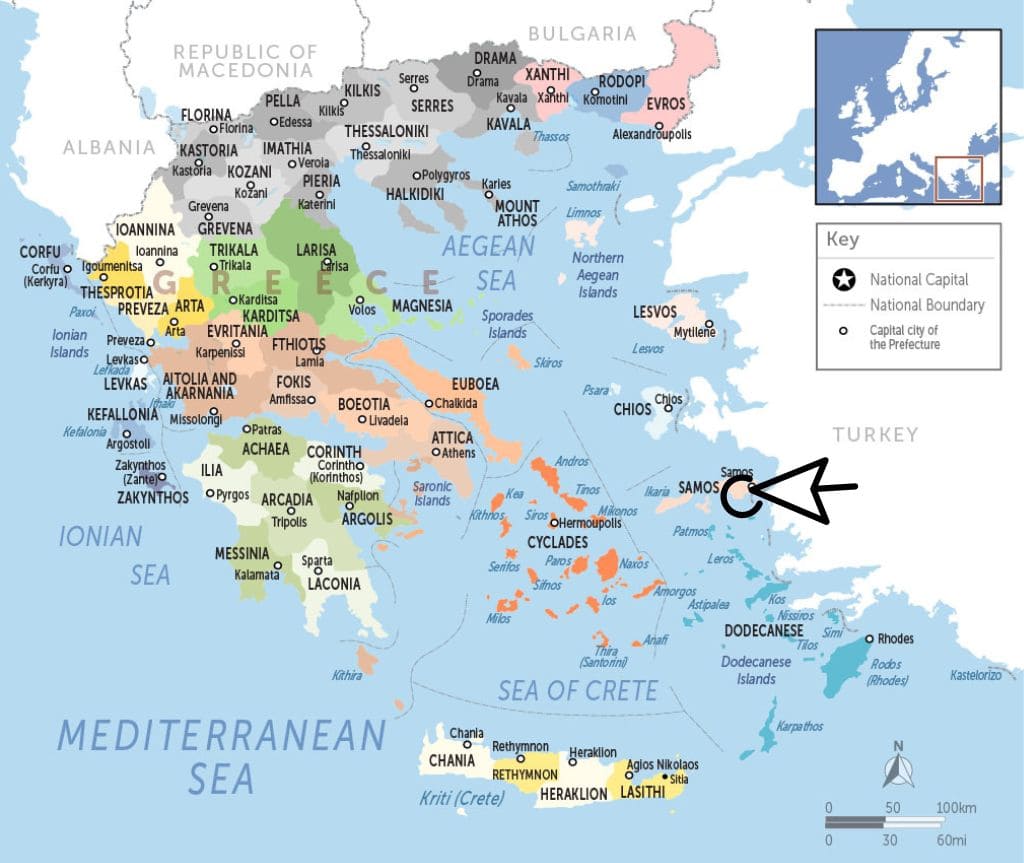
Samos is in the Eastern Aegean, south of the island of Chios and north of the island of Patmos. The narrow straights of Micale (also known as the straights of Samos), just over 1 km wide, separate Samos from the Turkish coast. Samos is quite verdant and large and rather mountainous, which offers great natural vistas as you explore the island’s various historical locations or seek out its beautiful beaches.
The climate of Samos is Mediterranean, like all of Greece: it gets very hot summers and relatively mild winters. Temperatures during the summer can climb up to 35 degrees Celsius and even up to 40 degrees during heat waves. During the winter, temperatures can drop to 5 degrees Celsius and as low as 0.
The best time to visit Samos is from mid-May to late September, which is the entirety of summer in Greece. If you’re looking to avoid crowds or get better prices, then try to book in September. The sea is at its coldest swimmable temperature in May and early June, while September tends to have warmer seas.
How to get to Samos
You can go to Samos by plane or by boat.
If you opt to go by plane, you can book a flight from Athens or Thessaloniki. The trip takes roughly an hour from either city.
If you opt to go by ferry, you can take one from Athens’ port of Piraeus. Just make sure you book a cabin because the trip lasts roughly 12 hours. There are also other ferry connections to Samos from several other islands such as Syros, Mykonos, and Chios.
Click here for the ferry timetable and to book your tickets.
Or enter your destination below:
How to get around Samos
Samos has a good road network, so you can get around the island very easily, either by car or by bus.
You can rent a car to have freedom of movement around the island and get to the beaches you wish to explore.
I recommend booking a car through Discover Cars, where you can compare all rental car agencies’ prices, and you can cancel or modify your booking for free. They also guarantee the best price. Click here for more information and to check the latest prices.
Alternatively, you can use the local bus (KTEL), which has scheduled bus routes around the island and tickets at affordable prices.
A Brief History of Samos
Samos was a powerful and rich island since quite early in antiquity. It was known as the birthplace of the goddess Hera, the wife of Zeus and goddess of women, family, and marriage. By the 7th century BC, Samos had become a powerful naval city-state with booming commerce, especially of Samian wines and famous red pottery as well as bringing in textiles from Asia.
The island had powerful alliances with Egypt and was part of the Ionian League. Its naval prowess and keenness to explore were such that Samians are considered the first seafarers to reach Gibraltar. The peak of Samos’ power was during the 6th century BC when its tyrant, Polycrates, was ruling.
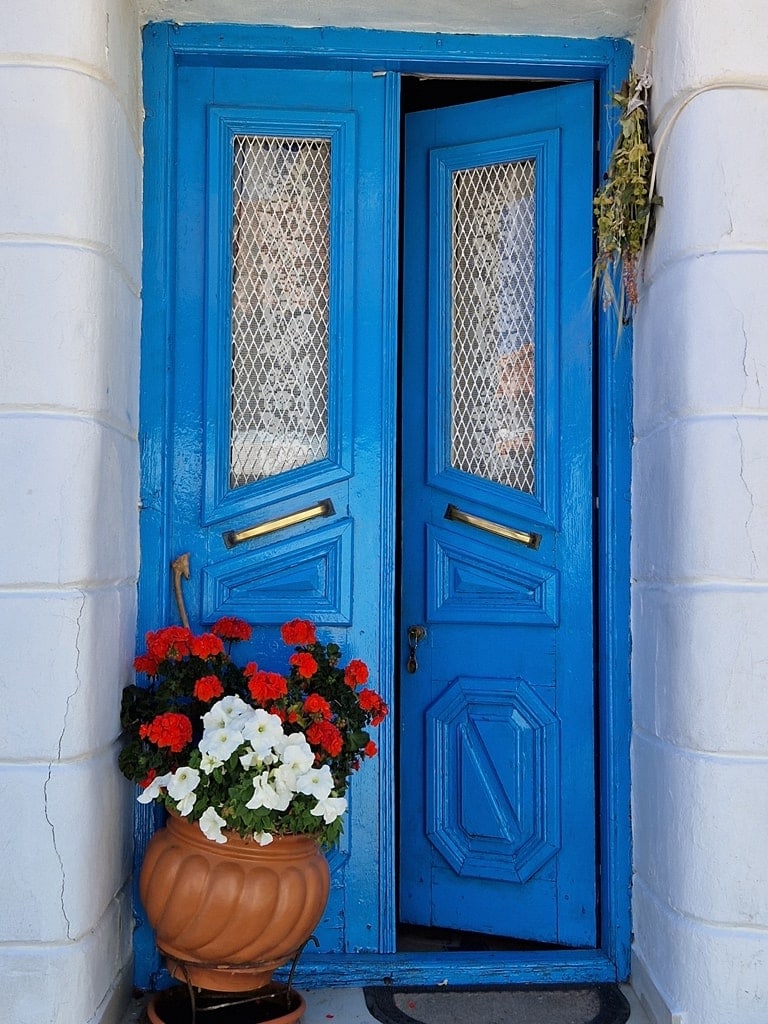
It was during his reign that the famous tunnel of Eupalinos was constructed: a tunnel through Samos’ Mt. Kastro that would connect the city of Samos to an aqueduct and secure freshwater that enemies wouldn’t easily cut off.
Still, Samos fell to the Persian Empire after Polycrates’ death. Afterward, it joined the revolt against Persia together with other islands and later the other Greek city-states. A decisive battle won against the Persians, the battle of Mycale, took place right across the Samian coast, on the coast of Asia Minor.
During the Byzantine times, Samos was an important part of the Byzantine Empire and later, during the 12th century AD, fell to Genoese rule.

Samos was conquered by the Ottomans in 1475 when it was weakened by plague and rampant piracy. During that time, Samos slowly regained its naval prowess and, in 1821, joined the Greek War of Independence.
Though they were prominently successful in the war, the Great Powers initially didn’t recognize Samos as part of Greece. Samos became an independent state in 1913 because Samians refused to accept Ottoman rule again. In 1913, Samos finally became part of Greece.
Famous Ancient Greeks of Samos
Samos is the home to two of the most famous ancient Greek personalities: the fable maker Aesop and the mathematician Pythagoras. The philosophers Epicurus and Melissus of Samos were also born on the island.
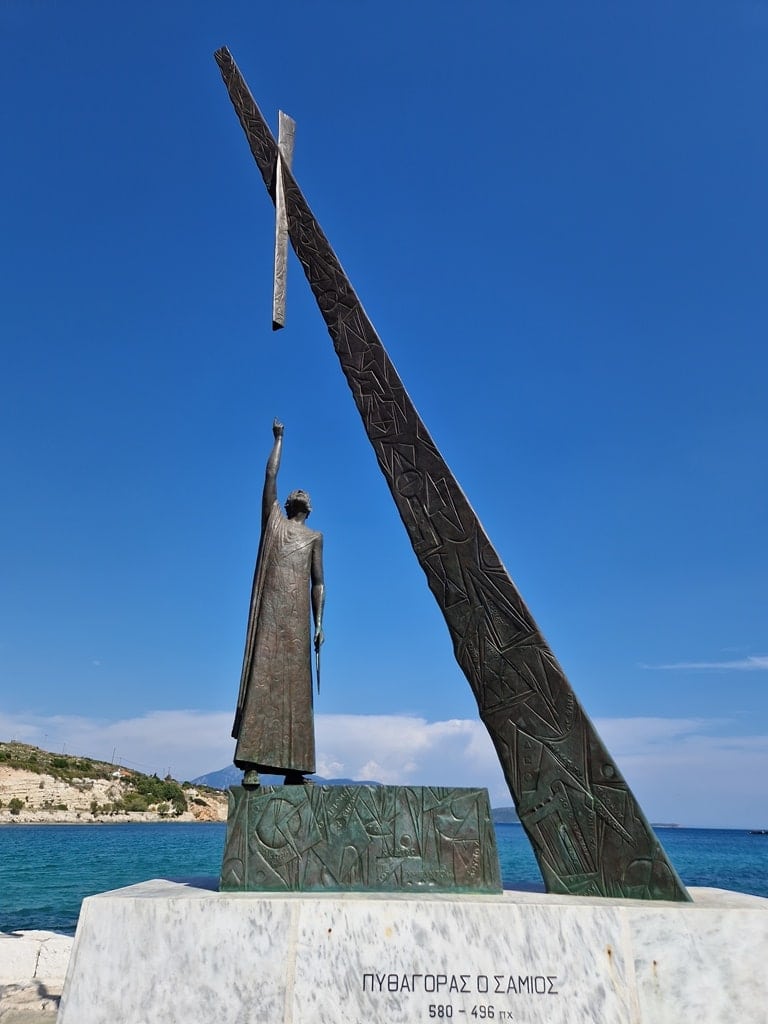
Pythagoras was especially influential not only in his science but also in teaching his distinct way of living, including his cult of mysticism.
Things to see and do in Samos
Samos is a diversely gorgeous island, with beautiful places to explore and visit regardless of your interests. From gorgeous natural vistas to archaeological sites and picturesque villages of distinct architectural styles, there are simply too many things to see. So here are the ones you can’t miss:
Explore Vathy Town
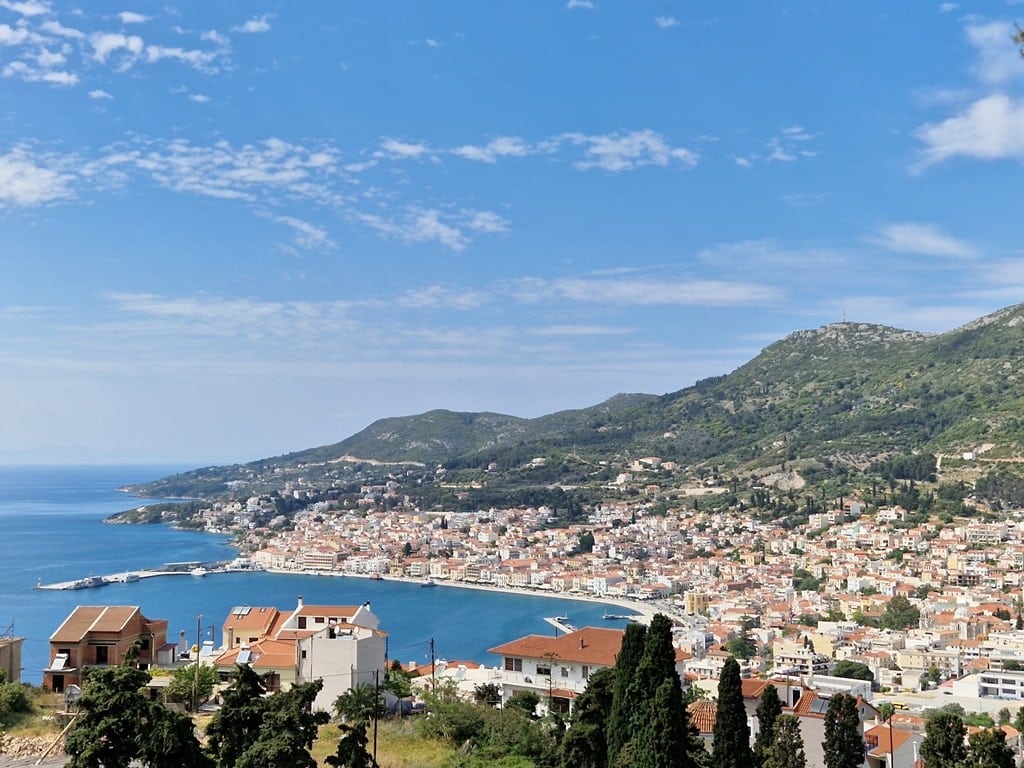
The beautiful Vathy is Samos’ Chora and one of its main three ports. It is located in the northeastern part of Samos, with beautiful, characteristic red roof houses clustered around the bay. In truth, Vathy and Samos’ Chora originally were two separate settlements that merged.
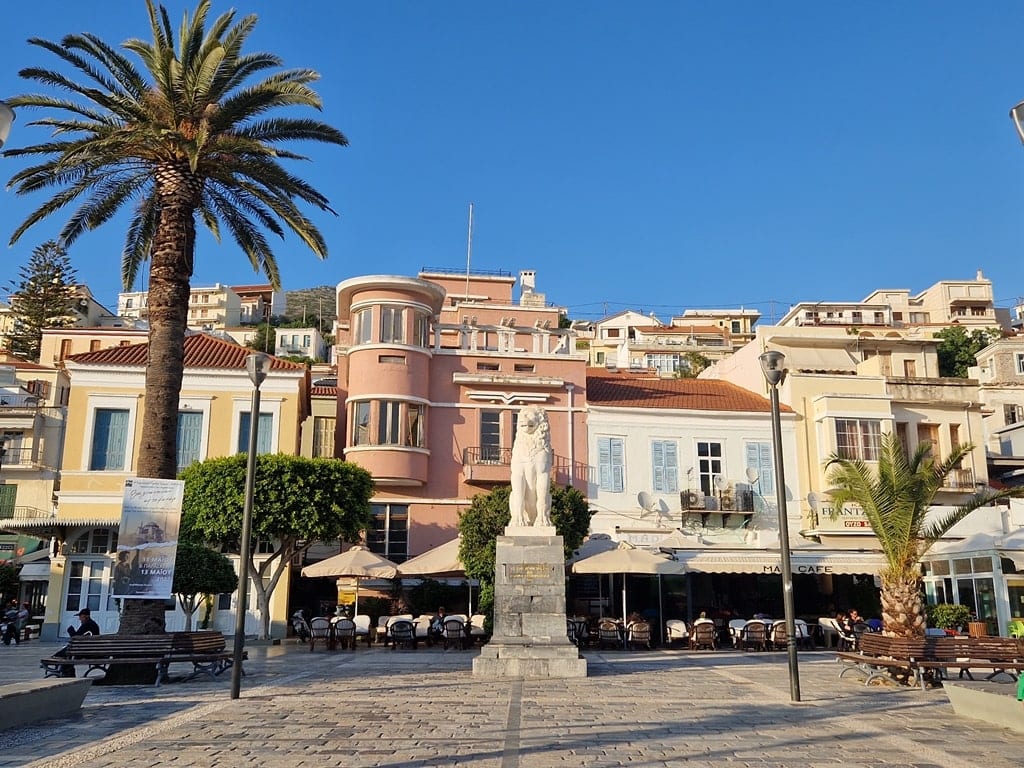
Explore Vathy’s neoclassical neighborhoods and beautiful Venetian-era buildings. The winding pathways are Instagram-worthy, with vibrant colors and gorgeous views. When you need a breather, choose one of the many cafés and restaurants around town to be refreshed.
Explore Pythagorio Town
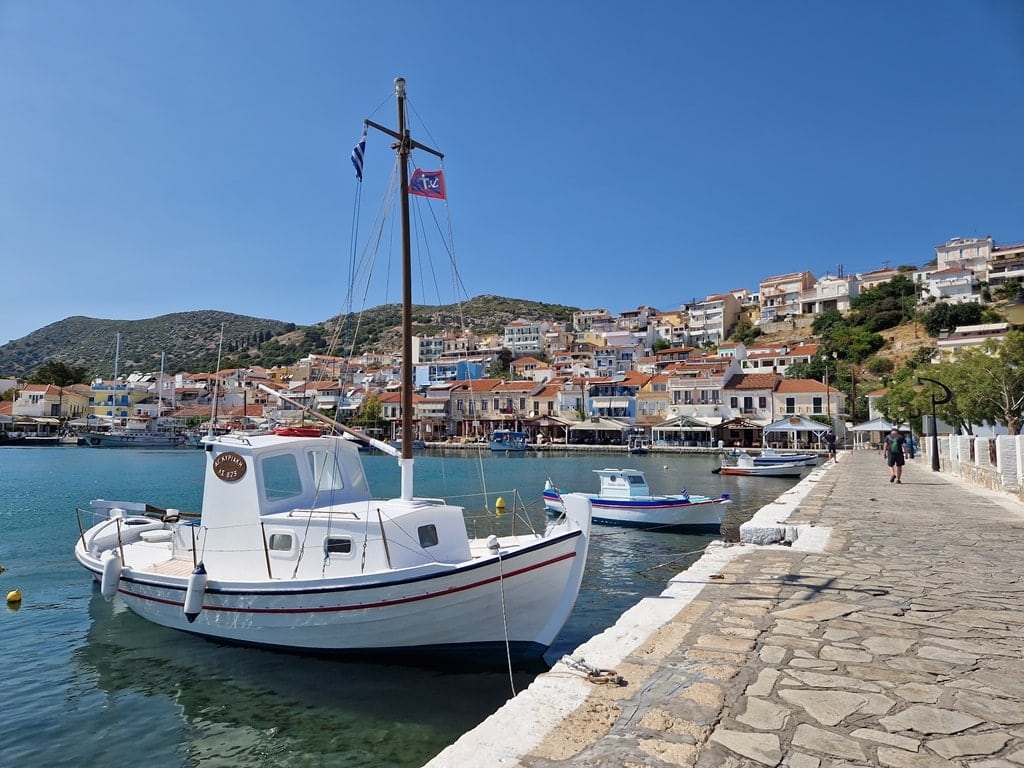
Pythagorion is where the ancient main city of Samos was. You will find it 11 km from Vathy. Pythagorion is another harbor town, where most cosmopolitan vessels moor.

The town is a marvel of 3 millennia of history, where calm relaxation meets cosmopolitan flair. It comes as no surprise that most of the highly important archaeological sites are situated around Pythagorion. The town itself boasts two firsts, as it has the first-ever human-constructed harbor of the Mediterranean and the first-ever tunnel, both made during the reign of the tyrant Polycrates in the 6th century BC.
All of that has made Pythagorion a UNESCO World Heritage site, so don’t miss out on exploring its picturesque, elegant streets and feel surrounded by immense history.
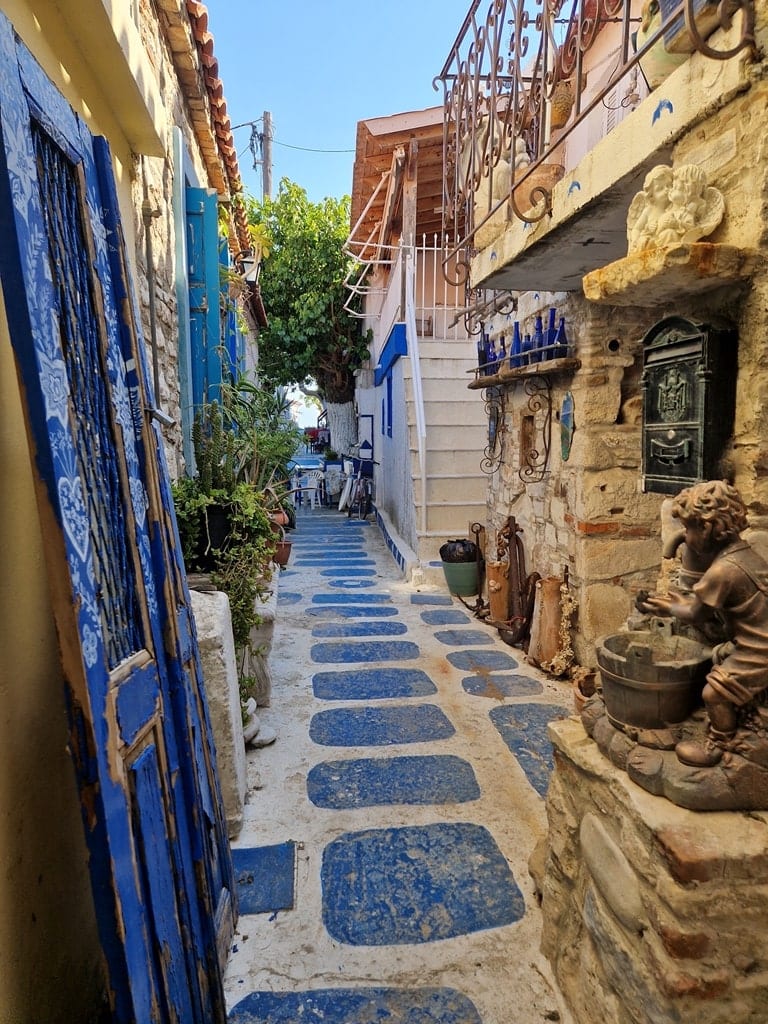
Find your way to the town’s Blue Street, where everything is painted blue and white, and visit the looming Tower of Lykourgos Logothetis, an Independence War captain. The tower wasn’t only the residence of this revolutionary leader and a solid fortification against the Turkish forces, built in 1824.
You might also like: A Guide to Pythagorion Town.
Explore the villages
Manolates: Manolates is a beautiful, traditional mountain village on the slopes of Mt. Ampelos, 23 km from Vathy. The mountain’s name means “grapevine,” and that’s what the villagers mostly cultivate: grapes for immediate consumption and for excellent local wine.
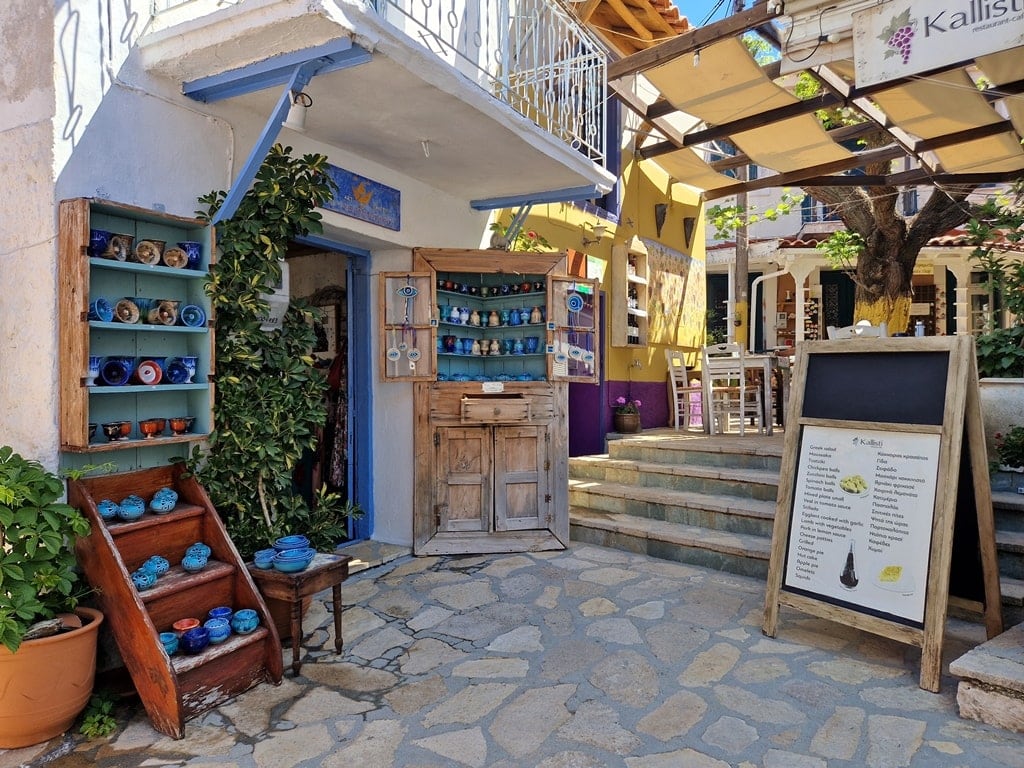
The village is swathed in a lush forest, with breathtaking views from the sloping side. On good days you can see the coast of Asia Minor up close. The village itself is beautiful with old, well-preserved houses and beautiful pathways.
Kokkari: This gorgeous fishing village is an excellent place for relaxation and romance, situated 11 km from Vathy. Known for its beautiful colorful turn-of-the-century houses and sprawling vineyards, Kokkari is popular as a destination for atmospheric cocktails, and unforgettable seaside experiences as the beaches nearby are some of the most beautiful.
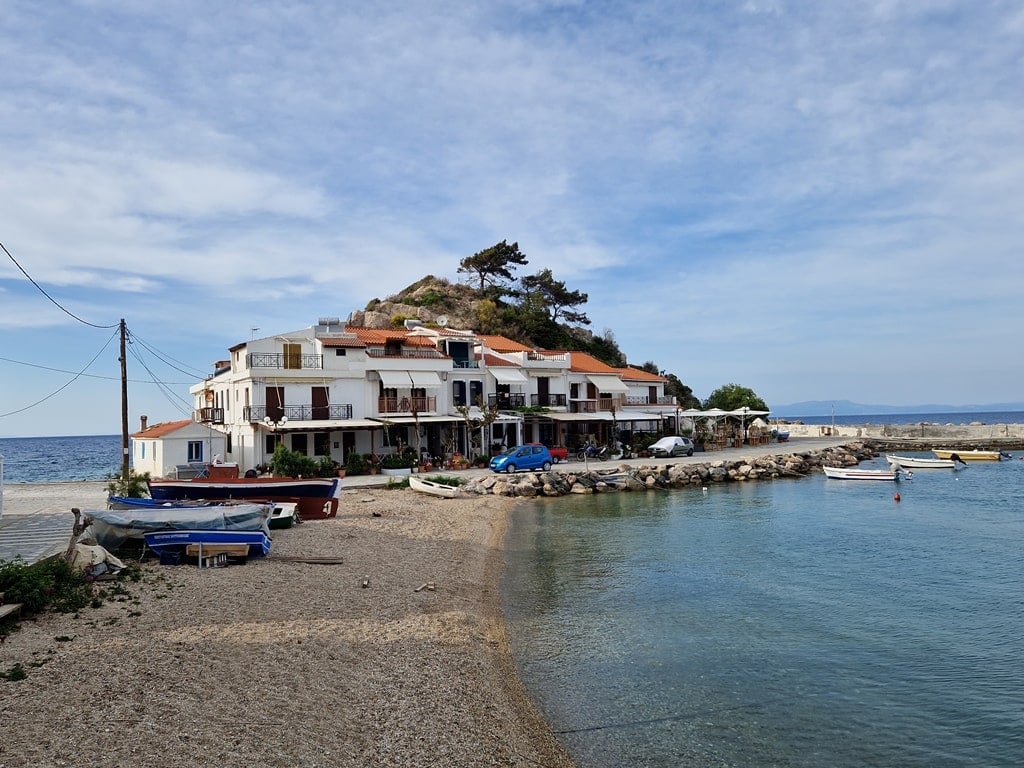
Karlovasi: This is the second biggest town of Samos and one of the most beautiful. With 19th-century neoclassical mansions and opulent buildings scattered at the top of a lush, verdant hill, Karlovasi’s affluent history is evident.
Don’t miss out on its gorgeous churches and especially Aghia Triada (Holy Trinity), right at the top of the hill. Explore further to find the ruins of a Byzantine castle and beautiful waterfalls.
Visit Spiliani monastery

The monastery of the Virgin Mary of Spiliani (the name means “of the cave”) is unique because it is built in a cave near Pythagorion. The cave itself is manmade, hewn out of the rock in the mountain. You will need to hike up to the monastery built around it and then descend down 95 steps in the hewn-out rock to find the chapel in the cave.
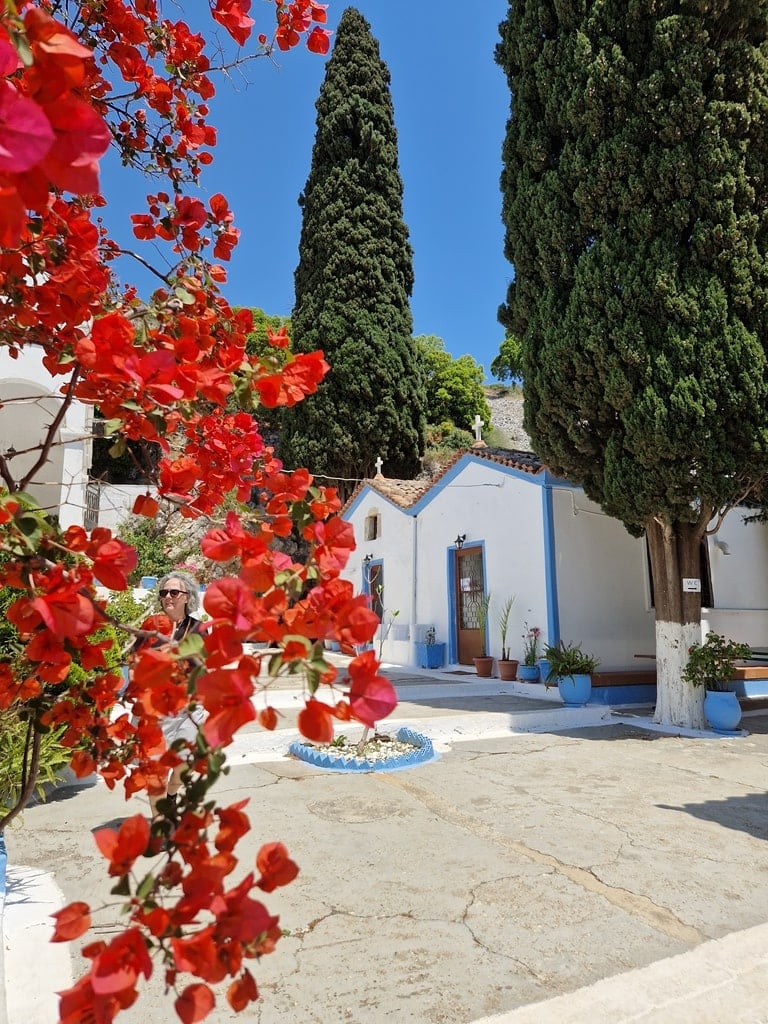
The cave was created before the time of Pythagoras and has been a place of worship since then. There are some theories that there even was an oracle of the Sybil Phyto there around 600 BC. There is also an icon of the Virgin Mary that is said to perform miracles.
The craftsmanship of the cave is exquisite, and the atmosphere is something you will need to experience for yourself.
Visit the museums
Archaeological Museum of Samos: Close to the port of Vathy, housed in a beautiful neoclassical building and a second, modern one, you will find this remarkable museum, considered one of the most important provincial ones.

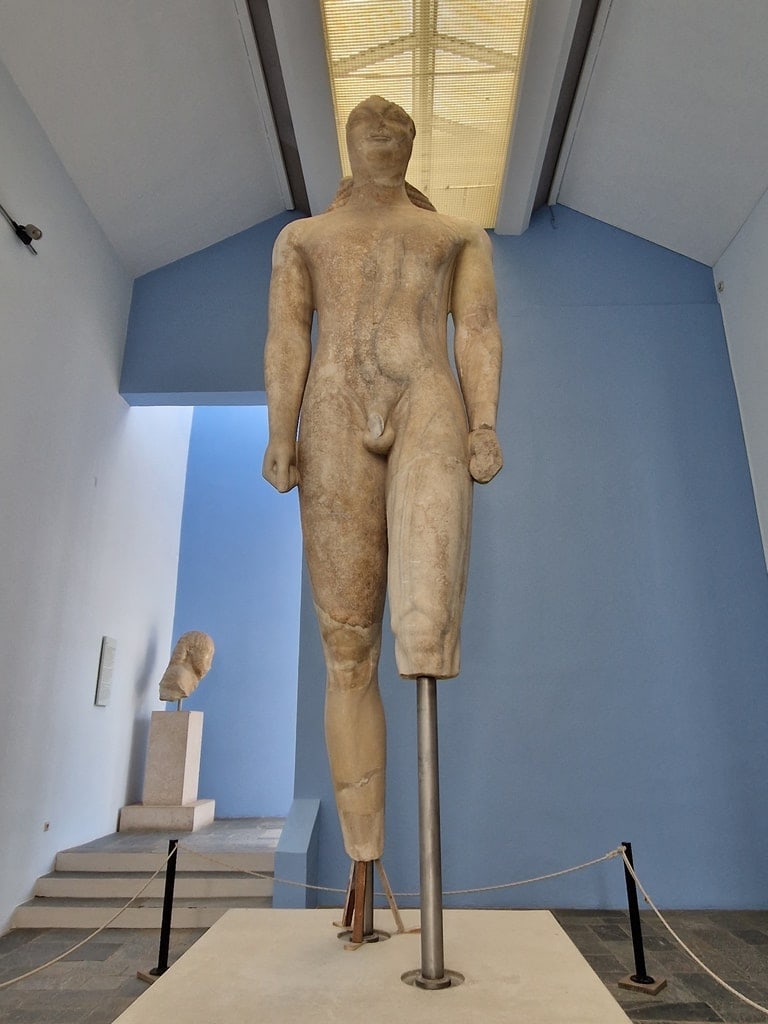
You will be able to enjoy rich collections of exhibits from the various archaeological sites in Samos, featuring artifacts from prehistoric times to Hellenistic times. There are items from as far away as Egypt, from Samian commerce, and several statues, including a 4-meter-high Kouros.
Archaeological Museum of Pythagorion: This museum is housed in a modern building and holds artifacts from the surrounding archaeological sites and, most importantly, the Heraion. You will be seeing rare grave steles and beautiful statues and busts from various eras, including Roman times. Look out for the sarcophagus shaped like a temple and the statue of Emperor Trajan.

Explore the archaeological sites
The Heraion: 7 km from Pythagorion, you will find the ruins of the Heraion Sanctuary. The name means “Sanctuary of Hera,” and myth has it that it was the place where Zeus and Hera had their honeymoon. For Samos, the Heraion was and remained a sacred place of pilgrimage for several centuries.

The Sanctuary had a sacred road that connected it to the city of Samos and a temple that was built next to the river Imvarsos because that was the location of the birth of Hera. The temple was gigantic for the era, standing at nearly 23 meters tall and 112 meters wide. Today a column remains erect, and there are remnants of the various friezes.
The tunnel of Eupalinos: This tunnel is astounding not only because it’s the first tunnel of its kind ever made in the Mediterranean, but also because of how it was constructed and the level of mathematics and engineering required to make it a reality.
It took roughly ten years to make, with two crews hewing out the rock of Mt. Kastro from both ends of where the tunnel would be at the same time. You can enter the tunnel, which is roughly in the shape of a square with 1,80-meter sides. However, make sure you don’t suffer from claustrophobia as there are areas where it narrows down considerably.
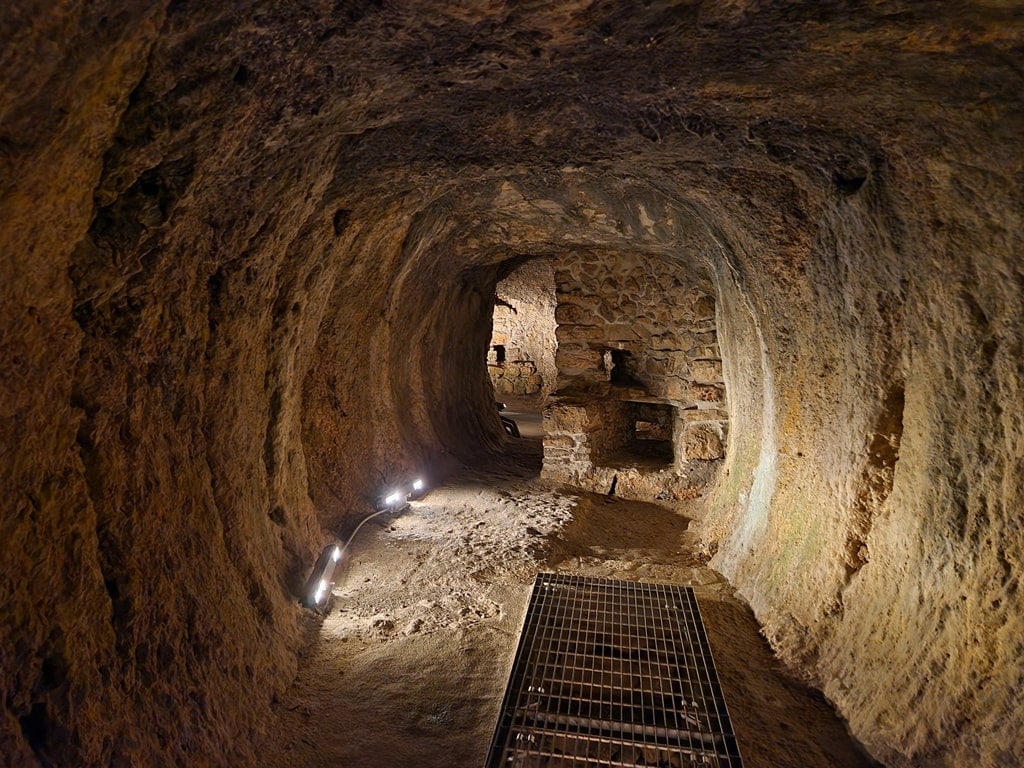
There are three Itineraries that you can take to enter the tunnel, with various difficulties in terms of walking through it: Itinerary 1 is the easiest, lasts 20 minutes, and allows you to see all aspects of the tunnel’s construction.

Itinerary 2 is harder, lasts 40 minutes, and allows you to additionally see a Byzantine cistern and where the two crews hewing out the rock met. Itinerary 3 is the hardest and lasts an hour.
You get to go through the entire tunnel and see everything on the other two itineraries plus the spring of water and the ancient cistern at Agiades, to which the tunnel was meant to connect.
Be careful to heed the guide’s instructions, and be aware that you won’t be allowed to carry bulky bags (or any bags) inside.
The archaeological site of Thermae: Thermae means “baths” and the archaeological site of Thermae was, indeed, where Roman Baths were around the 1st century BC. The complex is well preserved, with beautiful mosaics and distinctive different rooms for warm and hot baths, a sauna, and an octagonal pool. You will find the site of Thermae near Pythagorion.
Cave of Pythagoras: The tyrant Polycrates wasn’t on the best of terms with Pythagoras, the mathematician. So, when he sent men after him, Pythagoras hid in this cave at the eastern slope of Mt. Kerkis, the tallest mountain in the Aegean islands. The cave is two caves, one where Pythagoras lived and an adjacent one where he continued to teach his students.
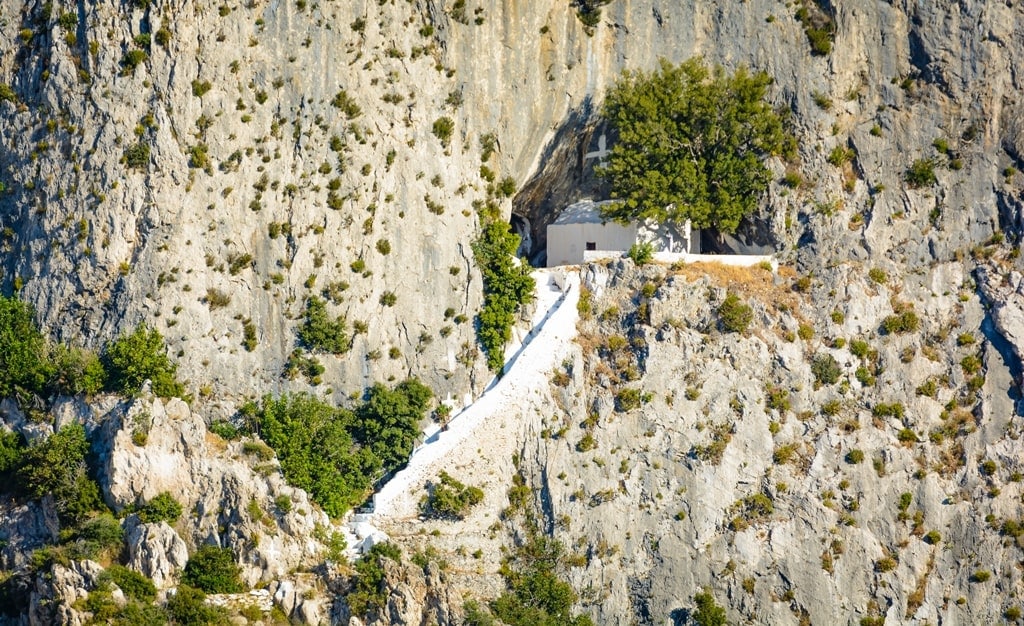
The cave is chambered inside and does look suitable for living. It also has gorgeous views and a spring nearby from where the mathematician is said to have gotten water. The path to the cave is excellent for hiking, with excellent views of the area’s lush, verdant nature. Two chapels are nearby dedicated to St. John and the Virgin Mary.
Hike to Potami Waterfalls
Near the beautiful village of Karlovasi, about 5 km away, there are the famous Potami Waterfalls: this is a site of immaculate natural beauty, huddled away in a gorge created by the waterbed of the river of Kastania (in ancient times, it was called Kerkitios).

The hiking route is simply gorgeous, as you leave the main road from Karlovasi to follow the riverbank into the gorge until you find a crystal-clear pond. If you are feeling adventurous, you can reach the first waterfall by swimming across and then, if you are skilled in climbing slippery rocks, climb up to find the second waterfall.

If you opt for safety first (which is the best), walk around the pond and up the steep wooden steps to the path leading you to the first and then the second waterfall. Both waterfalls are a couple of meters high, and the centerpiece is a canvas full of triumphant lush greenery and eons-old platan trees. If you are tired, you will find a beautiful little tavern that is built in a style suitable for the natural habitat around to get a refreshment.
Hit the beaches of Samos
Samos is full of breathtakingly beautiful beaches. No matter where you go on the island, you’re likely to discover at least one. But here are some that you simply shouldn’t miss out on:
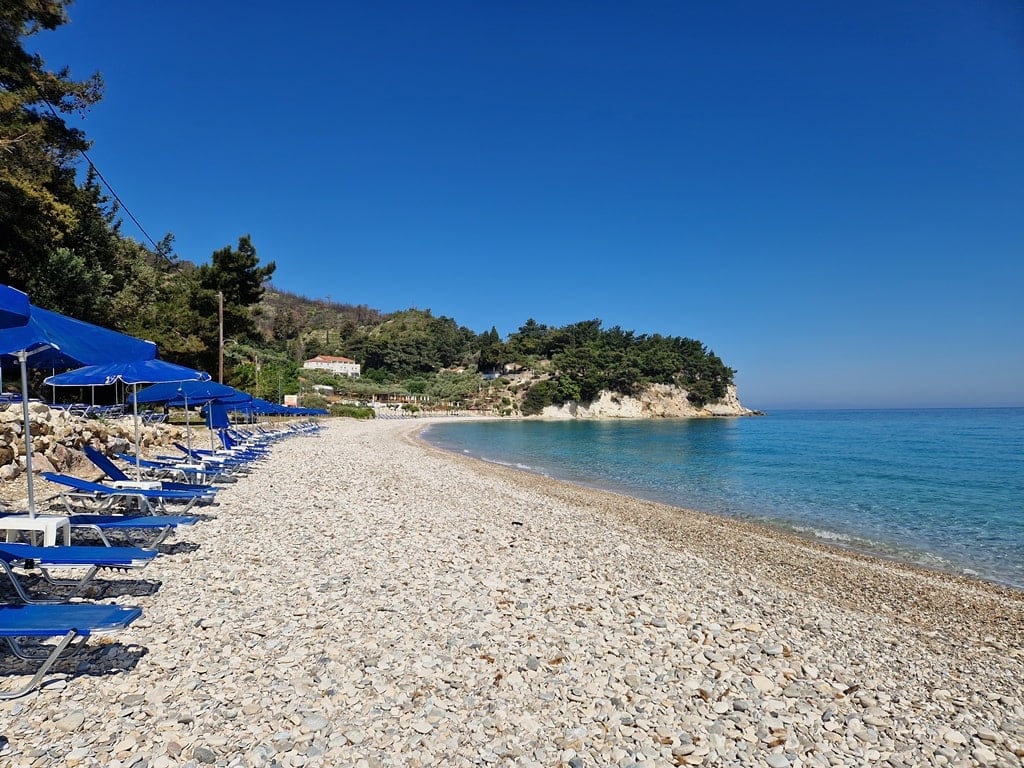
Tsamadou Beach: 13 km northwest of Vathy, the gorgeous Tsamadou beach is considered one of the most beautiful on the island. The beach is wreathed with lush verdant nature contrasting beautifully with the emerald blue of the waters. The rock formations add a special unique touch to the tableau of Tsamadou. The beach is partially organized, and there are a lot of taverns and cafeterias nearby.
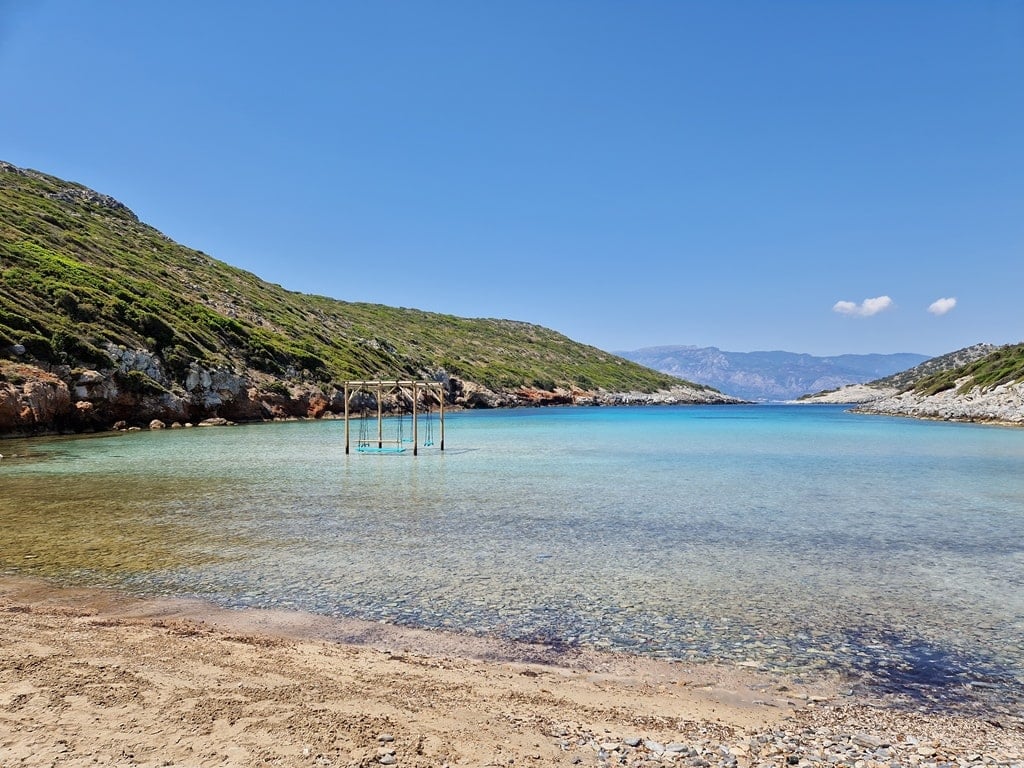
Livadaki Beach: This beach features lush golden sand and crystal clear waters that feel exotic. The beach has shallow waters which make it perfect for families with young children. It is relatively small and popular, so make sure to go early for a good spot. There are sunbeds and umbrellas, but they fill up fast!
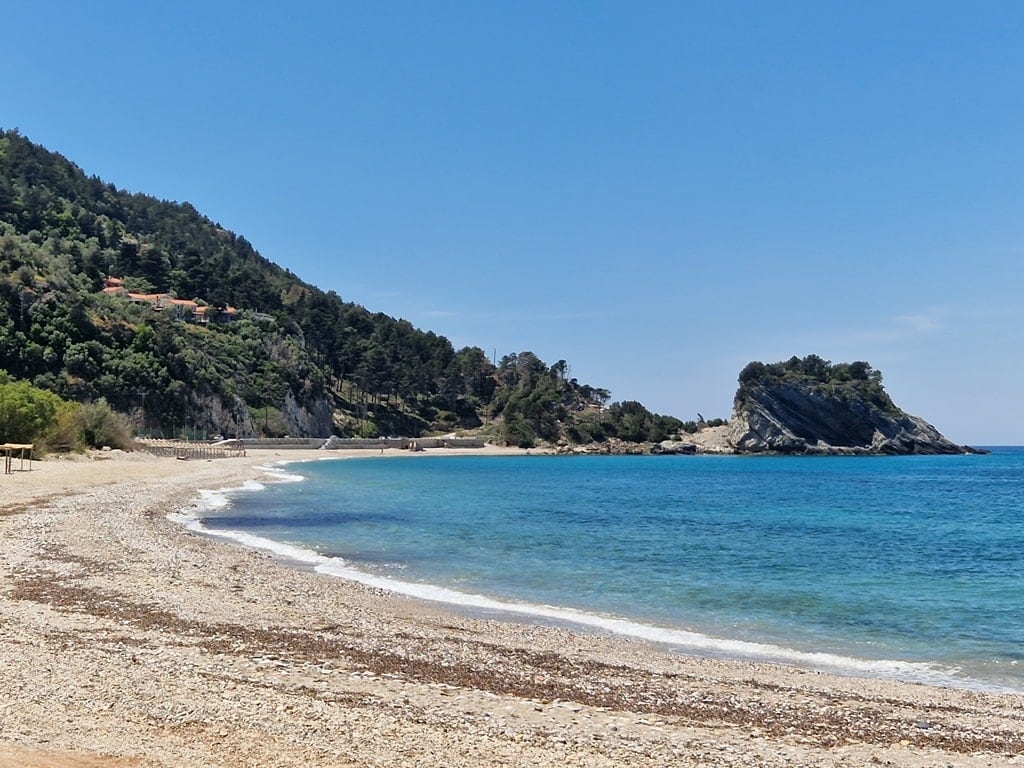
Potami Beach: Close to Karlovasi you will find Potami Beach, which is sandy and partially shaded naturally by trees. The waters are a turquoise blue that reflects the natural green and the blue of the sky. Cliffs and rock formations make this beach wildly beautiful. There are sunbeds and umbrellas available for rent and a beach bar nearby.
You might also like: The best beaches in Samos.
Take a day trip
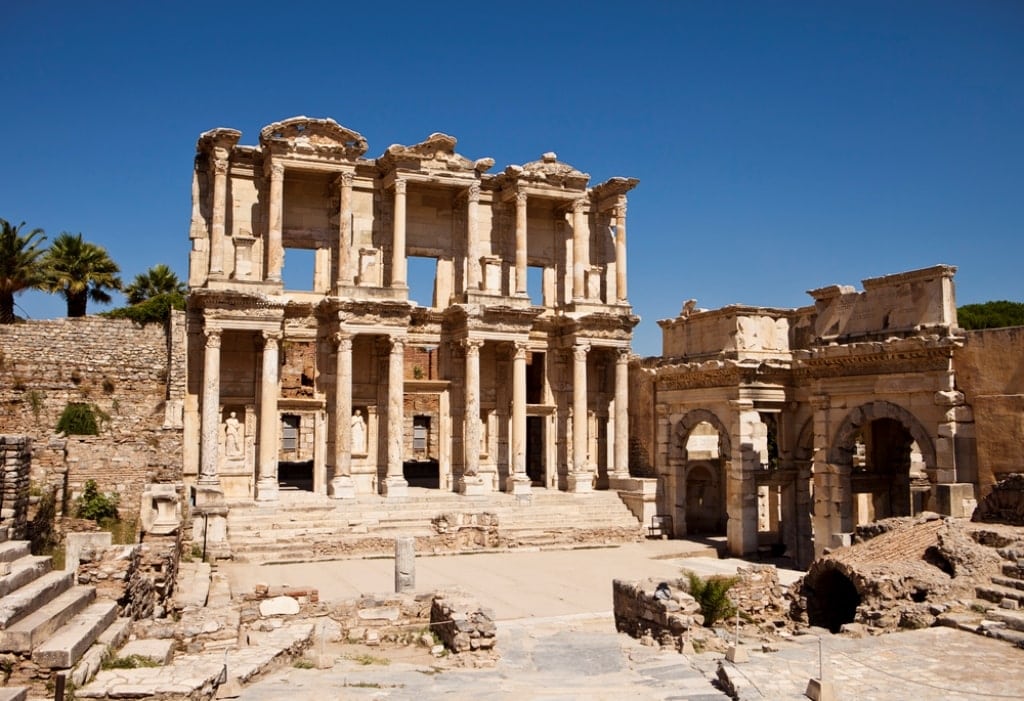
Kusadasi and Ephesus: Samos is only an hour or so away from the coast of Turkey, so it’s a prime opportunity to take a day trip to two of the most popular destinations there, Kusadasi and Ephesus! Kusadasi is an important and historic port city that is very popular with cruises.
It has always been an important trading center and the way to the famous city of Ephesus. Walk through the magnificent ruins of the ancient city of Ephesus and lounge at the various cosmopolitan watering holes of Kusadasi.
Take a boat to Samiopoula island: South of Samos, there is a tiny little island that is secluded, exotic, and stunningly gorgeous. You can go there only by a traditional wooden boat. The island is inhabited only by goats but has several tiny virgin beaches, with the main one, Psalida, being of silky sand and emerald waters. If you want to feel like you’ve run away from the world for a day, this is the day trip for you.

Day trip to Patmos island: Patmos is tremendously important for the Orthodox Christians, often dubbed the Jerusalem of the Aegean, since it is the island where Apostle John wrote his Gospel and the Apocalypse, the last book in the New Testament.
Beyond that, Patmos is gorgeous with dramatic cliffs and volcanic soil. Visit Patmos’ Chora for its picturesque arched pathways, the Monastery of St. John, which was built in 1066 and is fortified like a castle, and the Cave of the Apocalypse, where Apostle John stayed while writing the Book of Revelations.
Partake in the wine culture
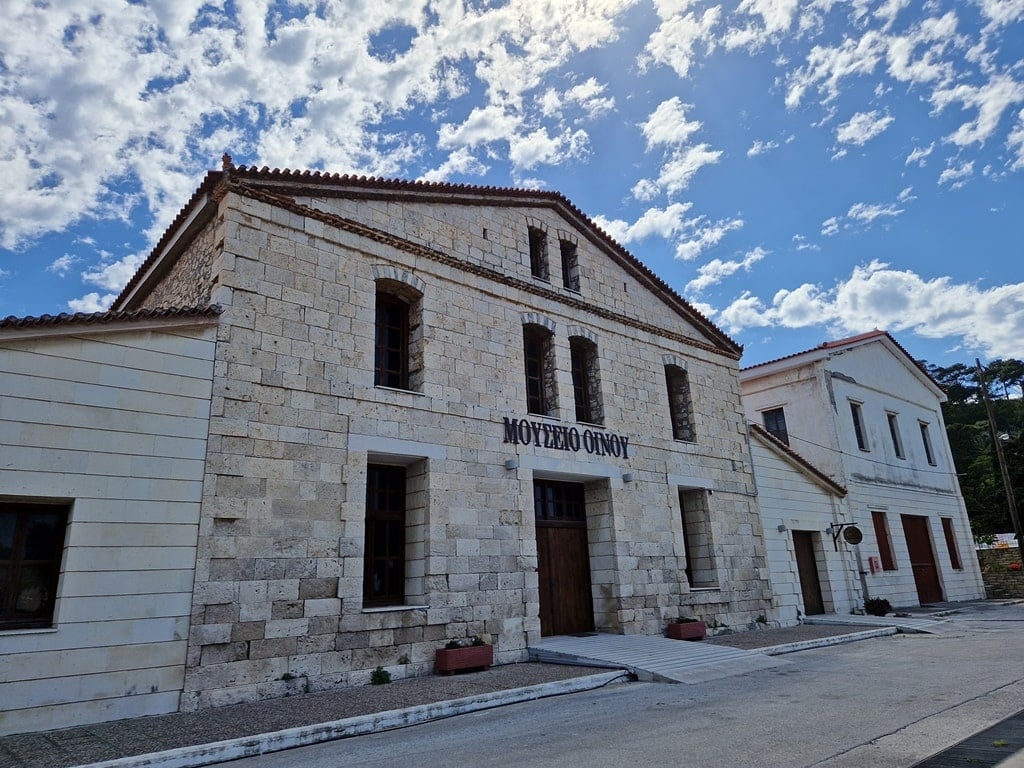
Samos has had a rich and famous wine history since the earliest of its ancient history. A history that is ongoing today, producing wine with a heritage of a few millennia. You can’t visit Samos without exploring its fascinating wine culture.
Samos Wine Museum: Samos Wine Museum was founded in 1934 and has been producing top-quality Samian wines. Several international prizes have been won with various wine labels produced here. Visit the Museum for a tour of the premises and a trip through the history of one of the oldest types of wine. You can also take a wine test, which is included in the price of admission.
Wine of Samos (Muscat Wine): This wine is the authentic, ancient sweet wine that made Samos a commercial force in antiquity all across the Mediterranean. The variety used today (muskat) became prevalent in the 16th century from the coasts of Asia Minor.
The varieties of sweet Samian wine you should sample at least once are:
- Samos Vin Doux is said to be the best wine in its price range.
- Samos, a muskat variety that is grown in the Samian highlands and has a distinct gold color
- Samos Anthemis, a muskat variety that has the smell of flowers in its bouquet (hence its name)
- Samos Nectar, a sun-dried muskat grape variety for a milder, softer taste compared to the intensity of the other varieties
No matter which you decide is your favorite, you will feel like tasting Samian wine is tasting a bit of history.

